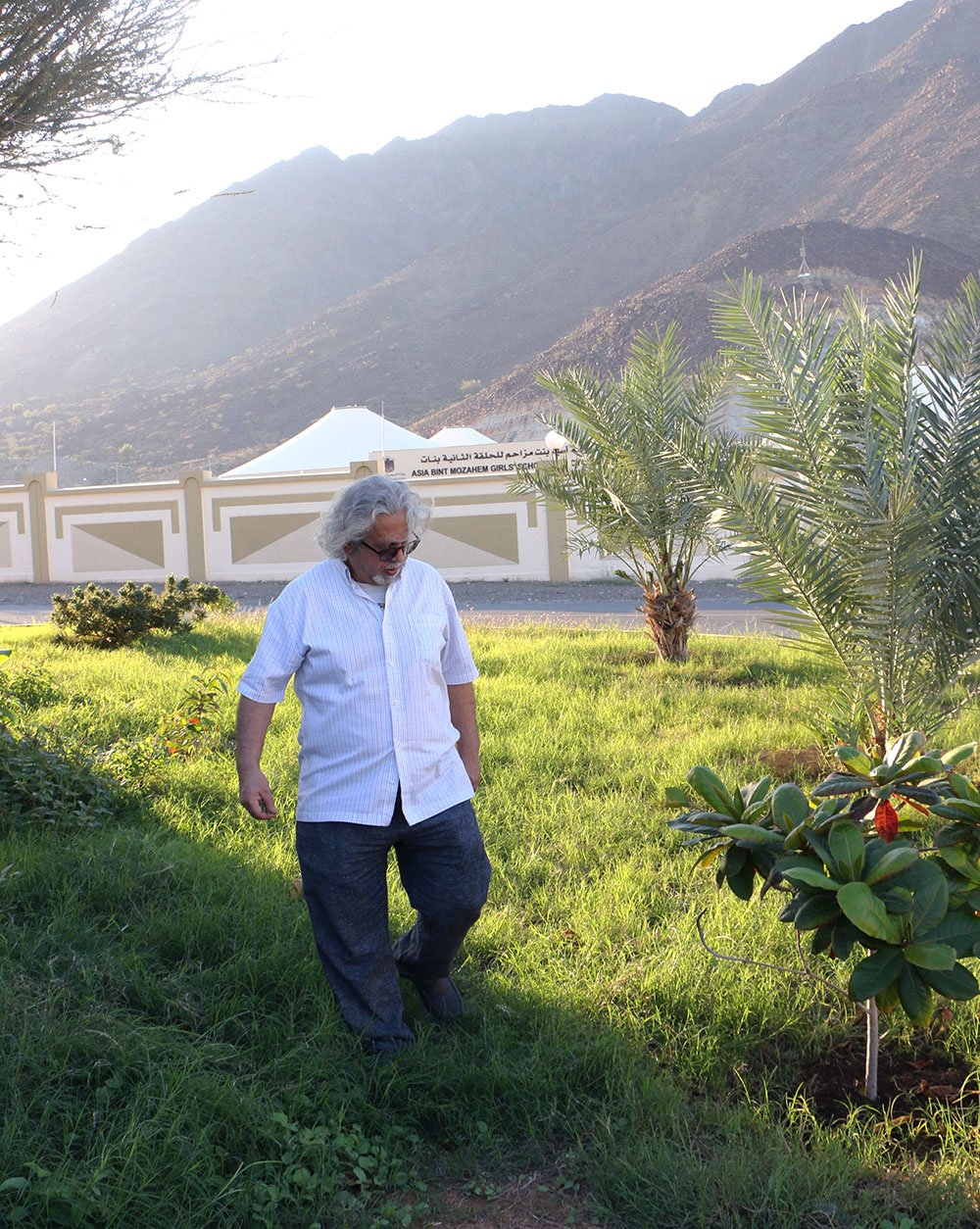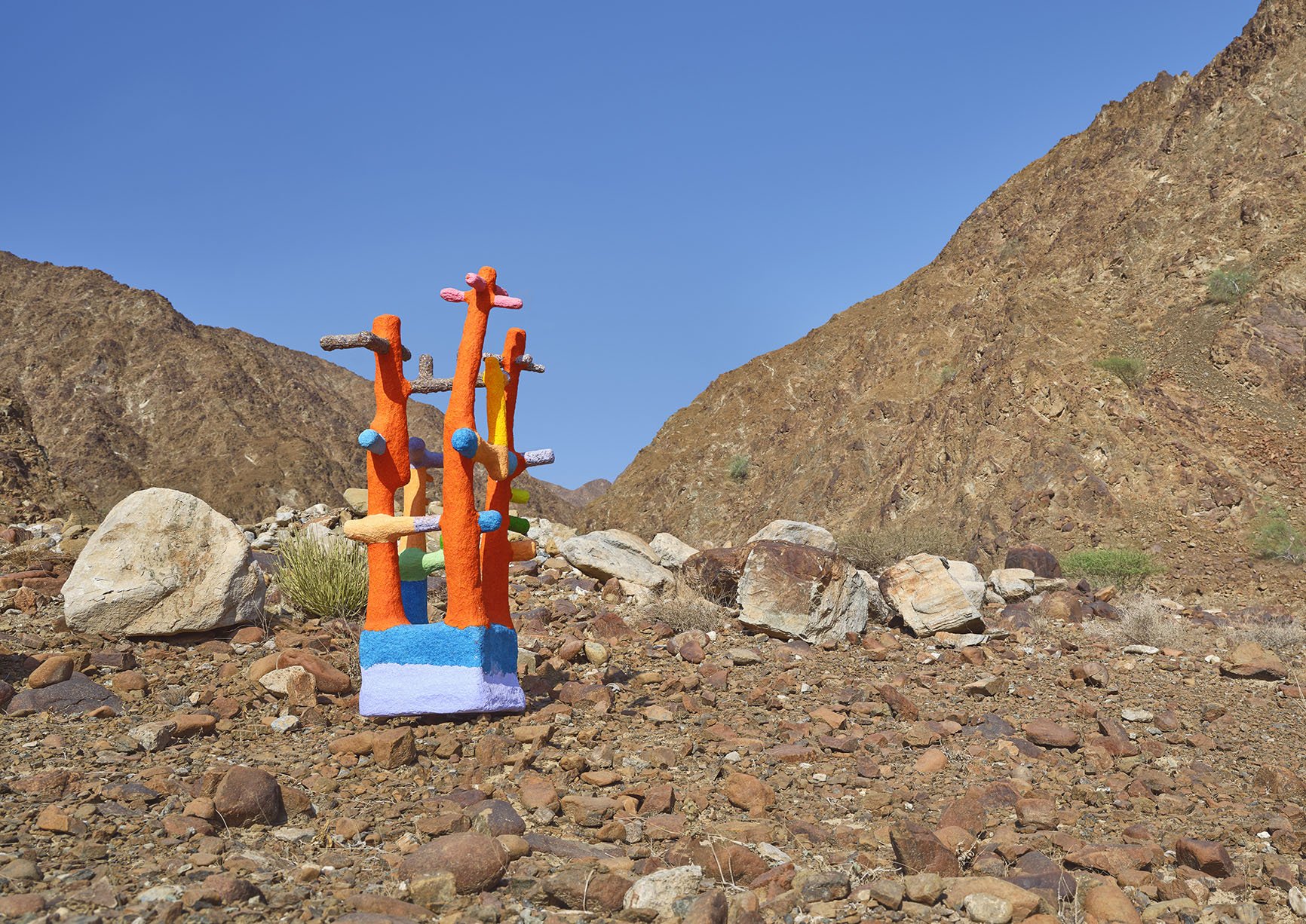A Porous Practice: Mohamed Ahmed Ibrahim
Between Sunrise and Sunset is a single installation of 128 abstract and organic elements. The exhibition is inspired by Ibrahim’s deep connection to the physical environment of his hometown, Khorfakkan, on Sharjah’s east coast. Image courtesy of National Pavilion of UAE, La Biennale Di Venezia
One of the most prolific artists in the UAE, Mohamed Ahmed Ibrahim crafts his work in the mountains of Sharjah’s Khorfakkan and represents his nation at this year’s Venice Biennale.
How do you encapsulate more than four decades of work of one of the most quietly prolific artists in the UAE? This was the dilemma facing Maya Allison, curator of the National Pavilion of the United Arab Emirates at this year’s Venice Biennale.
To allow the viewer to focus on the experiential aspect of Mohamed Ahmed Ibrahim’s work, Allison asked for a single piece, but a complex one, both sculptural in form yet porous in meaning and in character.
Between Sunrise and Sunset, a collection of 128 human-sized sculptural elements, populates the UAE Pavilion in Venice’s former shipyard district, the Arsenale. The elements ask for “a non-verbal comprehension,” Allison says. “This is the largest piece [Ibrahim] has ever made and it is not something you can really explain. You have to experience it to understand it. It is our hope that this will open up curiosity and other perspectives on the people and the landscapes of the UAE.”
It took Ibrahim two years to make the brightly coloured, bulbous and biomorphic forms. He used raw papier-mâché, incorporating rough texture with grass, dirt, and leaves coming from Ibrahim’s regular forages into the mountains that surround his home studio. He also used tea, coffee, and tobacco—staples in the artist’s almost-reclusive atelier. The sculptures have been called abstract and even land art because of their reference to the landscape in which Ibrahim was born.
However, they are neither one nor the other. “His work doesn’t fit easily into one category or another,” Allison says. “He sources material from his environment, which happens to be a really dramatic landscape, so then the shorthand becomes land art, even though obviously the sculptures are not land art.” Nor are they really abstract, Allison muses. Instead, she sees them as systems and process-based art, but even then definition is elusive. This is the heart of Ibrahim’s success as an artist. Be it sculptural, painting or drawing, he portrays shapes that resemble something familiar but are also indescribable.
Mophamed Ahmed Ibrahim at the foot of the mountains in Khorfakkan. Image Courtesy of National Pavilion UAE, La Biennale Di Venezia. Photo by Cheb Moha.
“I always like to give the viewers an open invitation to interpret my work as they like. I don’t want to frame any ideas,” Ibrahim says. “Someone can see these sculptures as figures, whereas for someone else they are animals, plants, or flowers. Everyone is right. It is actually most interesting for me when children see my work; they are freer in their expression.”
Human subjectivity informs Ibrahim’s practice, perhaps stemming from his earlier studies of psychology at Al Ain University (class of 1986). All readings of the work are valid, and it is his ability to speak to a primordial part of the viewer that brings a deep connection.
Previous works and exhibitions have continually tackled this subject. A solo show, Primordial, ran at Cuadro Gallery in Dubai in 2014. After switching his gallery to Lawrie Shabibi, in the city’s Alserkal Avenue, his other shows have also probed the workings of the subconscious mind. As Ibrahim shapes his thoughts about artworks and later turns those thoughts into forms, he looks to patterns made by absent-minded doodling or the swirling lines and abstract symbols that flash up between the eyelid and the eyeball. Through this meditative and almost unthinking process, he has created his own visual language, which is simultaneously unique and universal.
“I think that part of his training as a psychologist has fed into how he frames his work and his understanding of the viewers’ experience of the art,” Allison says. “By allowing the subjectivity of whatever psychological state you are in to come to the work, that will be reflected in what you’re going to find in the work.
“He also talks a lot about the memory drum,” Allison continues, “which is an access to pre-language memories and is definitely something that was part of his training in psychology.”
In psychological literature, memory drum is a theory that unconscious neural patterns acquired from past experiences are stored in the central nervous system within a memory storage organ. Ibrahim, fascinated by this and by his sense that children have an innate knowledge beyond conventional communication, made a series titled Memory Drum in 2020 during lockdown, which resulted in his previous exhibition.
This deeper dive into the working of human memory and language, combined with his career-long obsession with colour, culminated in the presentation in Venice. As well as being a meditation upon the mind’s inner workings, his work for Venice is also an homage to the land.
The work was created from raw papier-mache and natural materials such as dirt, leaves, tea, coffee and tobacco. Images courtesy of National Pavilion of the UAE, La Biennale Di Venezia
The title, Between Sunrise and Sunset, is a direct reference to the artist’s use of bright, almost garish colours. Growing up in Khorfakkan, a small enclave on Sharjah’s east coast that is flanked by mountains on three sides, Ibrahim didn’t see the sun set until he visited Kuwait at the age of six. These early memories of spending afternoons cast in a grey, washed-out shadow have continued to play an important role for him, even as he turns 60.
The tension between Khorfakkan’s colourful mornings, when the sun rises over the ocean, and the disappearance of colours in mid-afternoon is also the cyclical journey that Allison wanted for the viewer during the curation of her piece.
“The theme that we agreed—Between Sunrise and Sunset—has an implicit reference to the landmass of the UAE, because the UAE has the sunrise on one side and sunset on the other, but it is also a reference to the movement of light across Khorfakkan,” she explains.
Maya Allison. Image Courtesy of National Pavilion UAE, La Biennale Di Venezia. Photo by Mohamed Somji of Seeing Things.
However, such is the nature of Ibrahim’s work that the art piece itself carries with it a kind of porous ability to adapt to any environment it is in.
“Nothing is straight in Venice; all the walls are crooked and the old buildings seem to move as if the whole city is a boat. And when we took Mohamed’s work there it just naturally adjusted to it; it almost came to life, like it knew that’s where it was supposed to be going. It really does sort of take on its own personality in that context,” says Allison, who is also executive director of the New York University Abu Dhabi Art Gallery.
In that way, Between Sunrise and Sunset melds fluidly with the theme of the Biennale: The Milk of Dreams. In her curatorial statement, Cecilia Alemani suggests this title to indicate magical fantasy, bodies and metamorphosis. Ibrahim’s work teeters between imagination and reality, uses corporality and fuses it with fantasy and, as Allison notes, can metamorphose into any environment, making it the perfect fit for this event.
THE EVOLUTION OF THE NATIONAL PAVILION
The selection of Ibrahim to represent the UAE in Venice signals a maturity to the national pavilion, which is now in its second decade. The pavilion professes to an artist-led practice—Ibrahim nominated his own curator—allowing a more natural and organic presentation to develop. At the opening ceremony in April, Noura Al Kaabi, the UAE’s Minister of Culture and Youth, called Ibrahim a “convention-defying artist.”
The national pavilion is shaping the UAE’s cultural landscape by realising Ibrahim’s work process through this exhibition, said Angela Migally, executive director of the Salama bint Hamdan Al Nahyan Foundation which commissioned the pavilion. “This exhibition is testament to our commitment to invest in the UAE’s art ecosystem, spearheading the growth and understanding of [its] creative community. Extraordinary artists like Ibrahim deserve global recognition.”
Mohamed Ahmed Ibrahim: Between Sunset and Sunrise, National Pavilion of the UAE, La Biennale Di Venezia, April 23 - November 27, 2022
Image Courtesy of National Pavilion UAE, La Biennale Di Venezia. Photo by Ismail Noor of Seeing Things





